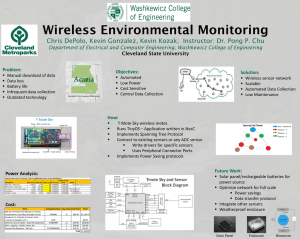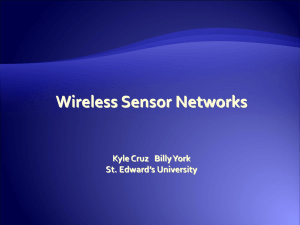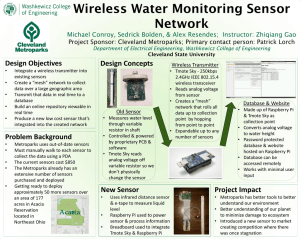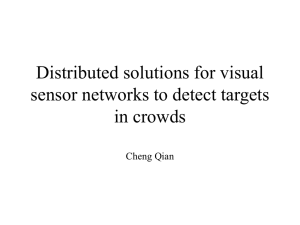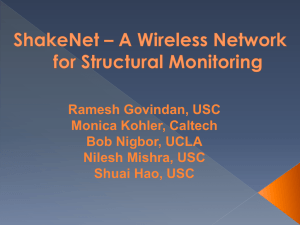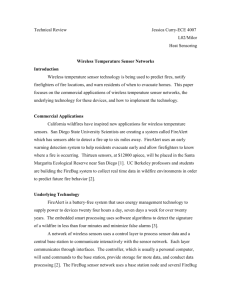Wireless sensor networks for off-shore oil and gas installations
advertisement
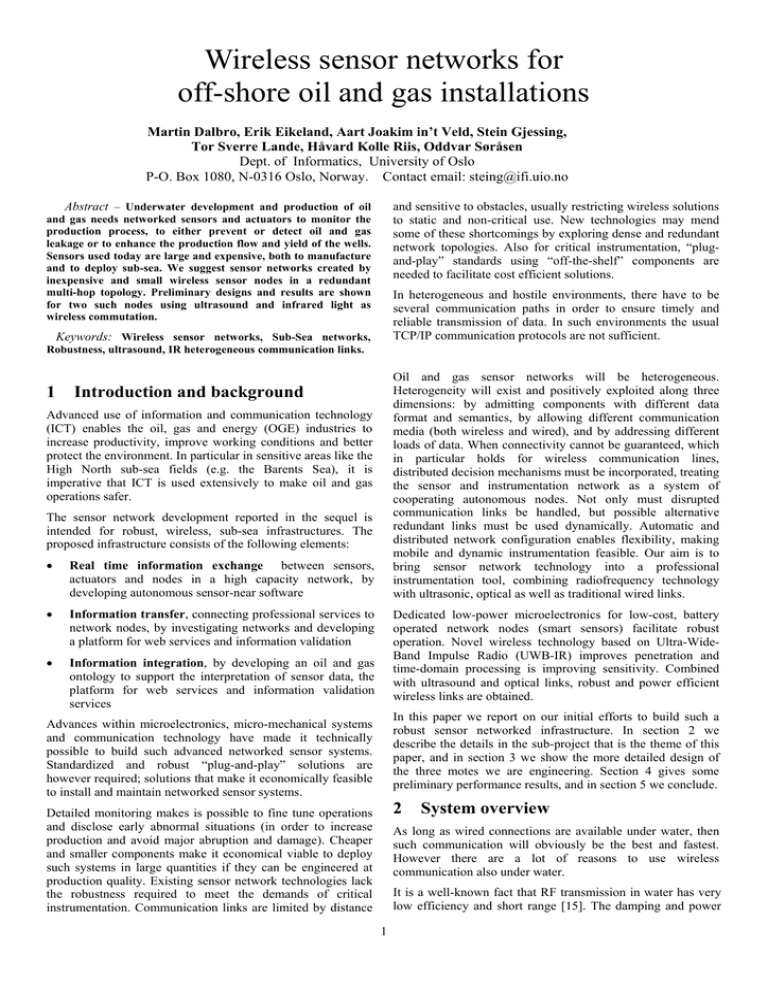
Wireless sensor networks for off-shore oil and gas installations Martin Dalbro, Erik Eikeland, Aart Joakim in’t Veld, Stein Gjessing, Tor Sverre Lande, Håvard Kolle Riis, Oddvar Søråsen Dept. of Informatics, University of Oslo P-O. Box 1080, N-0316 Oslo, Norway. Contact email: steing@ifi.uio.no Abstract – Underwater development and production of oil and gas needs networked sensors and actuators to monitor the production process, to either prevent or detect oil and gas leakage or to enhance the production flow and yield of the wells. Sensors used today are large and expensive, both to manufacture and to deploy sub-sea. We suggest sensor networks created by inexpensive and small wireless sensor nodes in a redundant multi-hop topology. Preliminary designs and results are shown for two such nodes using ultrasound and infrared light as wireless commutation. and sensitive to obstacles, usually restricting wireless solutions to static and non-critical use. New technologies may mend some of these shortcomings by exploring dense and redundant network topologies. Also for critical instrumentation, “plugand-play” standards using “off-the-shelf” components are needed to facilitate cost efficient solutions. In heterogeneous and hostile environments, there have to be several communication paths in order to ensure timely and reliable transmission of data. In such environments the usual TCP/IP communication protocols are not sufficient. Keywords: Wireless sensor networks, Sub-Sea networks, Robustness, ultrasound, IR heterogeneous communication links. 1 Oil and gas sensor networks will be heterogeneous. Heterogeneity will exist and positively exploited along three dimensions: by admitting components with different data format and semantics, by allowing different communication media (both wireless and wired), and by addressing different loads of data. When connectivity cannot be guaranteed, which in particular holds for wireless communication lines, distributed decision mechanisms must be incorporated, treating the sensor and instrumentation network as a system of cooperating autonomous nodes. Not only must disrupted communication links be handled, but possible alternative redundant links must be used dynamically. Automatic and distributed network configuration enables flexibility, making mobile and dynamic instrumentation feasible. Our aim is to bring sensor network technology into a professional instrumentation tool, combining radiofrequency technology with ultrasonic, optical as well as traditional wired links. Introduction and background Advanced use of information and communication technology (ICT) enables the oil, gas and energy (OGE) industries to increase productivity, improve working conditions and better protect the environment. In particular in sensitive areas like the High North sub-sea fields (e.g. the Barents Sea), it is imperative that ICT is used extensively to make oil and gas operations safer. The sensor network development reported in the sequel is intended for robust, wireless, sub-sea infrastructures. The proposed infrastructure consists of the following elements: • Real time information exchange between sensors, actuators and nodes in a high capacity network, by developing autonomous sensor-near software • Information transfer, connecting professional services to network nodes, by investigating networks and developing a platform for web services and information validation • Information integration, by developing an oil and gas ontology to support the interpretation of sensor data, the platform for web services and information validation services Dedicated low-power microelectronics for low-cost, battery operated network nodes (smart sensors) facilitate robust operation. Novel wireless technology based on Ultra-WideBand Impulse Radio (UWB-IR) improves penetration and time-domain processing is improving sensitivity. Combined with ultrasound and optical links, robust and power efficient wireless links are obtained. In this paper we report on our initial efforts to build such a robust sensor networked infrastructure. In section 2 we describe the details in the sub-project that is the theme of this paper, and in section 3 we show the more detailed design of the three motes we are engineering. Section 4 gives some preliminary performance results, and in section 5 we conclude. Advances within microelectronics, micro-mechanical systems and communication technology have made it technically possible to build such advanced networked sensor systems. Standardized and robust “plug-and-play” solutions are however required; solutions that make it economically feasible to install and maintain networked sensor systems. 2 Detailed monitoring makes is possible to fine tune operations and disclose early abnormal situations (in order to increase production and avoid major abruption and damage). Cheaper and smaller components make it economical viable to deploy such systems in large quantities if they can be engineered at production quality. Existing sensor network technologies lack the robustness required to meet the demands of critical instrumentation. Communication links are limited by distance System overview As long as wired connections are available under water, then such communication will obviously be the best and fastest. However there are a lot of reasons to use wireless communication also under water. It is a well-known fact that RF transmission in water has very low efficiency and short range [15]. The damping and power 1 consumption are increasing with transmission bandwidth and large antennas for sending and receiving are required. A way of expanding the practical possibility of underwater communication would be to use light or sound (hydro acoustic) for telemetry and data exchange. In this project tiny wireless motes of type Moteiv Tmote Sky have been equipped with IR and ultrasonic transceivers. This allows us to investigate an operation paradigm with parallel and redundant data channels in a wireless sensor network and to investigate main features of heterogeneous underwater wireless transmission technologies. 3 Detailed design In the following more details about the implementation of the various parts of the system are described. 3.1 The ultrasonic transceiver The mote extended with ultrasound transmission capabilities consists of an extension card having a sender of type Murata MA40S4S and a receiver of type Murata MA40S4R. Frequency shift keying has been chosen for the coding strategy, and frequencies of 39.8 kHz and 41.8 kHz are used for 0, 1 FSK-signaling [6]. Sharp LC band pass filters [8] for the receiver is used to discriminate between the frequencies. The filters have a 3 dB bandwidth of 1 kHz and a roll-off of 20dB at frequencies 3 kHz around the center frequency. The circuit diagram of the filter with amplifier is shown in figure 1. A level shifter is required to center operation on Vcc/2. The system will consist of multiple motes arranged in a multihop network. Each mote can collect sensor data or trigger an actuator (e.g. shutting a valve), do some preprocessing or signal conditioning and communicate the essential information to the rest of the network, e.g. operators located on-shore or on-sea. A multi-hop communication scheme of such wireless sensor nodes restricts the power consumption required compared for long distance transmission [10]. A primary optimization criterion would be to achieve low power consumption since the motes typically are battery operated. High reliability is a central issue for oil installations, this fact being exaggerated by the difficulty and cost of replacing and adding sub-sea units. The wireless communication should therefore have alternative, parallel transmission channels with the possibility of easy reconfiguration. Then critical data can be re-routed if some parts fail. An extra security feature is introduced utilizing different technologies for redundancy. Figure 1 Circuit diagram of the band pass filter Hydroacoustic communication is very reliable and feasible and has been used in a range of applications, in spite of the rather low bit-rate typically achieved, e.g. 100 – 1000 bit/s [10]. Our approach is to leave the more static configurations often used and combine the ultrasound operation paradigm with the flexibility of wireless motes placed in ad hoc and dynamic configurations. The resistance of the two load resistors must be twice the load resistance. On the negative feedback it is important that the two resistors of the voltage divider are dominating the load. This will keep the voltage at the desired Vcc/2. Once the signal is amplified to a suitable level, it is rectified with a diode rectifier charging up a capacitor. Once a certain voltage level is reached, the Tmote analog inputs detect a logic 0/1. The capacitor then discharges through a parallel resistor connected to ground. In optical communication the light is spread considerably from the transmitter and therefore the energy is widely distributed. This means that the transmission ranges from simple light sources will be restricted (unless focused), demanding a reduced range between the motes. To implement a full 3-D communication possibility each mote must have multiple light emitter and sensors to cover several directions. Figure 2 shows the printed circuit board adjacent to the mote. Since the ultrasound components would need a voltage source of 30 V, this voltage level has to be generated on-board from the 3 V given by the mote itself. The “booster” circuit is shown in figure 3 and is a standard [7] boost converter circuit with a low-voltage controlled sending stage: The M4 NMOS transistor acts as a switch for pulsing the current through the inductor L1. Once the ground reference of the inductor is disconnected, it will generate a high voltage to keep the current flowing. This charge is stored on capacitor C2 and C3. A minimum switching frequency is required to limit the current flow through inductor L1 and transistor M4. The actual motes chosen for this project, Moteiv Tmote Sky, has already an implemented RF transmission possibility, are battery operated and programmable in the TinyOS environment [11]. The built-in RF network transmission is ideal for test of the other communication technologies in the prototyping phase. Special extension cards for the ultrasound and IR light transducers have been developed in the project and plugged into the motes. The external components are controlled by appropriate drivers which cooperate with the operating system. A special card has also been designed for detecting motion and changes in the positional state of an underwater mote. The attached tiny PCB is instrumented with a three axis MEMS accelerometer. Information of the movement of a specified mote can thus be transferred through the network and to an operator. Correspondingly, if an operator is equipped with such a MEMS extended mote on land, he could control a camera or an underwater manipulator just by moving a glove having such a mote attached (e.g. implementing a “3-dimensional mouse”). 2 Figure 4 Relaxation oscillator [12]. 3.2 Optical transceivers Yet another technology for transmission is to use infrared (IR) transceivers. An extension PCB for the Tmote has been developed. The transceiver of type Agilent HSDL-3208 is a low power 115.2 Kbit/s infrared transceiver, operating at 850 ≤ λp ≤ 900 nm [3]. Figure 5 shows the configuration of the transceiver. Figure 2 Ultrasound transceiver and Tmote Sky The RF wireless link is based on the Chipcon CC2420 Zigbee transceiver [5]. The data is exchanged according to an IEEE 802.15.4 communication protocol using CSMA/CA. The Zigbee communication stack is controlled by a separate microcontroller, while the TinyOS operating system operates on a Texas Instruments MSP430 microcontroller. The TinyOS operating system cannot provide more than 1 ms timing accuracy [14] limiting the switching frequency to 1 kHz. This calls for use of analog oscillators for switching and communication control [12, 13]. Figure 5 Configuration of the optical transceiver. [3] A general network will typically have motes located at various non-regular positions, and each interface card should then be able to transmit in different directions. Viewing angel for the HSDL-3208 is 30-60 degrees. [3] Thus each mote needs four HSDL-3208 transceivers to enable a full utilization of a multipath wireless network concept. Figure 6 shows the IR communication system for a typical situation. Figure 3 Voltage booster circuit diagram. The sending stages is controlled by two parallel relaxation oscillators made from a Schmitt-trigger, a resistor and a capacitor [12] as shown in figure 4 and are set to oscillation frequencies of 39.8kHz respectively 41.8kHz by resistor and capacitor values. In figure 3, the oscillators are modeled as voltage source V3. These oscillators are activated by the digital output ports of the Tmote. The transistor M1 and M3 will then pull the output voltage to the voltage level charged on C2 and C3, and then down to ground as the sending frequency oscillates between ground and Vcc. Resistor R1 and diode D2 ensures that the M1 PMOS gate is held at the desired voltage level. Figure 6 Typical IR communication setup As for the ultrasound case the IR extension cards is interfaced to the mote through the TinyOS drivers and adhere to the same protocol hierarchy. We are using the Tmote Sky’s microcontroller to handle the information transfer directly 3 through the IR extension cards. This is not ideal, as the task handling of TinyOS is too slow to cope with high bitrates. To utilize maximum performance of the HSDL-3208 it is necessary to store data on the extension card, and provide the card with means to handle the bit transfer. Equipping each mote with multiple IR senders and receivers renders the possibility for relative positioning of the motes by measuring light intensities. Randomly scattered motes could report their position, mapping terrain and sub-sea installations. By using a TSL 251R light to voltage optical sensor as a receiver, we will be able to find the distance between two motes. A functional block diagram of TSL 251R is shown in figure 7. Figure 8 Tmote Sky with IR extension PCB with one HDSL-3208 IR transceiver 3.3 Moving sensor To be able to detect the motion of wireless sensor motes, an extension card with a three axis off-the-shelf MEMS accelerometer has been implemented (Analog Devices ADXL 330). The interface card is attached to the Tmote Sky and allows acceleration sensing in the x-, y- and z- directions. The readouts are represented as analog signals which are transferred directly to the Tmote for AD-conversion. The mote can use those data for a simple, local calculation of the relative movement of the compound device. Alternatively, the raw data can be wirelessly transferred to a network server for more comprehensive computations or actions. Figure 7 Block diagram of TSL 251R [4]. An indicator reading to find a calibrating value k based on the environment (clean vs. dirty water) is necessary. The light intensity diminish by square with the distance, thus the distance between two motes is given by the equation The current prototype has so far been designed for 3dimensional movements in open air. As mentioned in chapter 2, the device might be used as a wireless “3-dimensional mouse” for detection of hand movements. This can be used for manipulation and monitoring of sub-sea oil installations. The operator is then located on-shore with the accelerator-extended Tmote attached to one hand. (1) Processing data from only one optoisolator tells us that the transmitting Tmote is within sight of this sensor, providing a roughly relative position of the mote. The voltage is proportional with the amount of light received through the lens. Moving the transmitting Tmote right or left from the front of the TSL 251R sensor reduces the voltage even if the distance is the same. It is necessary to make a matrix of recorded voltages, storing the coherent values of varying distance and angel between two motes. It turns out that this kind of instrumentation may also be used for medical observations of e.g. elderly people wearing such a Tmote. Typical movement patterns and actions of patients can be detected (falling while walking, falling out of bed, sitting down, rolling over etc.). The test results for typical patterns will be the basis for a coarse classification, and relevant information can be shared over a Tmote sensor network with care-taking people. Equipping each extension card with multiple TSL 251R optoisolators with overlapping viewing angels enable the mote to compare the voltages to the stored matrix, and make a crossbearing of the position. By adding a calibration value based on environment, distance and orientation of one mote relative to the other is given. Multiple motes in range of each other could then transmit their position to each other to improve the calculation of the position. The prototype card with the tiny MEMS device mounted is interfaced to the Tmote through its input ports. Since this extension remedy is a purely sensing device, only the TinyOS input drivers have been used for interfacing. 4 4 infrared transceiver and its supporting components, as shown in figure 8. Performance 4.1 The ultrasonic transceiver performance One calibration readout is sufficient to find the calibration factor k, enabling us to estimate the distance between 2 motes. The calculated data is in this case based on a measuring distance of 80 cm. The calibration factor k can be calculated from equation 2: Results from simulation and the measured performance of the filter are shown in figure 9 and 10. (2) The measured value 0.6Volt at 80 cm gives the calibration value k = 0.6 × 80 2 = 3094 The results in figure 11 show a good match between the estimated distance between the motes based on voltage level (calculated data graph) and the actual measured distance. Figure 9 Simulated LC filter bandpass performance. Figure 10 Measured LC bandpass filter performance Figure 9 shows the simulated bandpass performance of the used LC filter interconnected with the amplifier. The simulation is from the filters output. The simulated filter has a -3dB bandwidth at 600Hz. Figure 11 Voltage and distance between 2 motes in air. Figure 10 shows the measured voltage charged on capacitor C2, which is detected by the Tmote analog input when a 1 volt sine signal of 20 periods is sent through the filter. The red curve (upper) shows the output while the signal matches the filters bandpass frequency, and the blue curve indicates the result while the other transmission frequency is received (suppression). As seen, the capacitor needs to be discharged, limiting the bit rate to one bit every 2ms. This gives a theoretical bit-rate of 500 bit/s. Based on the 1ms time accuracy of TinyOS, a more realistic estimation is around 300bit/s calculated from one bit being sent every 3ms. 4.3 Movement detection Typical detection patterns and classification for a group of relevant movements have still to be investigated. For both manipulation of actuators sub-sea or medical movement detection the Tmote with the MEMS sensors can preferably be connected to other Tmotes in a wireless sensor network, either by using traditional RF transmission or alternatively by the aforementioned ultrasound or light communication. This enhances the flexibility of the device and expands its application areas. Regarding power consumption, calculations indicates 7.5 mA through the branch to signal ground at any time when powered. In addition, the amplifier uses approximately 200 µA for each stage [9], giving a total of around 8 mA at idle before adding the sending stage. In other words, the ultrasound is a quite power consuming option. 5 Conclusions and future work In this paper we have presented a heterogeneous network solution suitable for underwater deployment. The combination of ultrasonic, optical and RF networks even as supplements to wires, is ensuring redundancy for robust and uninterrupted communication for critical industrial application like subsea oil and gas installations. 4.2 Optical transceiver performance In this early stage we are limiting our measurements and testing to a 2D plane, and the transmitting Tmote is directed directly against the receiving TSL 251R sensors. We are also transmitting from 1 mote at the time, eliminating the interference between simultaneous sending motes. We have shown the first experimental design, engineering and performance of two motes that facilitates such communication. In future work we will improve our designs, and build components that we will use to build and test a heterogeneous, fault tolerant and robust sensor network. The following measurements are found by equipping a Tmote Sky with a PCB extension card supporting 1 HSDL-3208 5 6 Acknowledgements Thanks to Ifi-drift, StatoilHydro and our colleague professor Sverre Holm. 7 References [1] Y. Chen, C. Qiao and X.Yu, “New results,” IEEE Network Magazine 18, 16-23 , May/June 2004. [2] Myungsik Yoo, Chunming Qiao, “This is the ways”, In Vertical Cavity Lasers, 1997 Digest of the IEEE/LEOS Meetings, pp. 26–27, Aug. 1997. [3] Agilent HSDL-3208 Ultra Small Profile Package IrDA® Data Compliant Low Power 115.2 Kbit/s Infrared Transceiver Data Sheet [online] Access:http://literature.agilent.com/litweb/pdf/59887857EN.pdf [2008-04-02] [4] TSL250R,TSL251R, TSL252R LIGHT_TO_VOLTAGE OPTICAL SENSORS Datasheet [online] Access:http://www.taosinc.com/images/product/docu ment/TSL250R-e30.pdf [2008-04-02] [5] Tmote Sky Low Power Wireless Sensor Module Datasheet [online] Access:http://www.sentilla.com/pdf/eol/tmote-skydatasheet.pdf [2008-04-02] [6] Data and computer communications 7th edt. William Stallings. s. 142-152 [7] Power electronics 3rd edition, Mohan, Undeland, Robbins, s. 172-178 [8] Electronic Filter design Handbook, 3rd edition. Arthur B. Williams, Fred J Taylor, s. 5.7-5.27 [9] Datasheet for STMicroelectronics TS912IN. [online] Access: http://www.farnell.com/datasheets/63486.pdf [2008-04-02] [10] Daniel B. Kilfoyle and Arthur B. Baggeroer, “The State of the Art in Underwater Acoustic Telemetry”. IEEE Journal of Oceanic Engineering, VOL. 25, NO.1, January 2000 [11] TinyOS Community Forum, Access: http://www.tinyos.net website. [online] [12] Datasheet for Phillips 74HC132N fig. 16, p.8 Access: http://www.farnell.com/datasheets/43297.pdf [200804-04] [13] The Art of Electronics, Horowitz & Hill, 2nd edition. p. 284-286. [14] TinyOS help, The Mail Archive [online] Access: http://www.mail-archive.com/tinyoshelp@millennium.berkeley.edu/msg12078.html [15] A. Baggeroer. “Acoustic telemetry- An overview.” IEEE J.Oceanic Eng., vol. OE-9. Pp.229-235, 1984. 6
